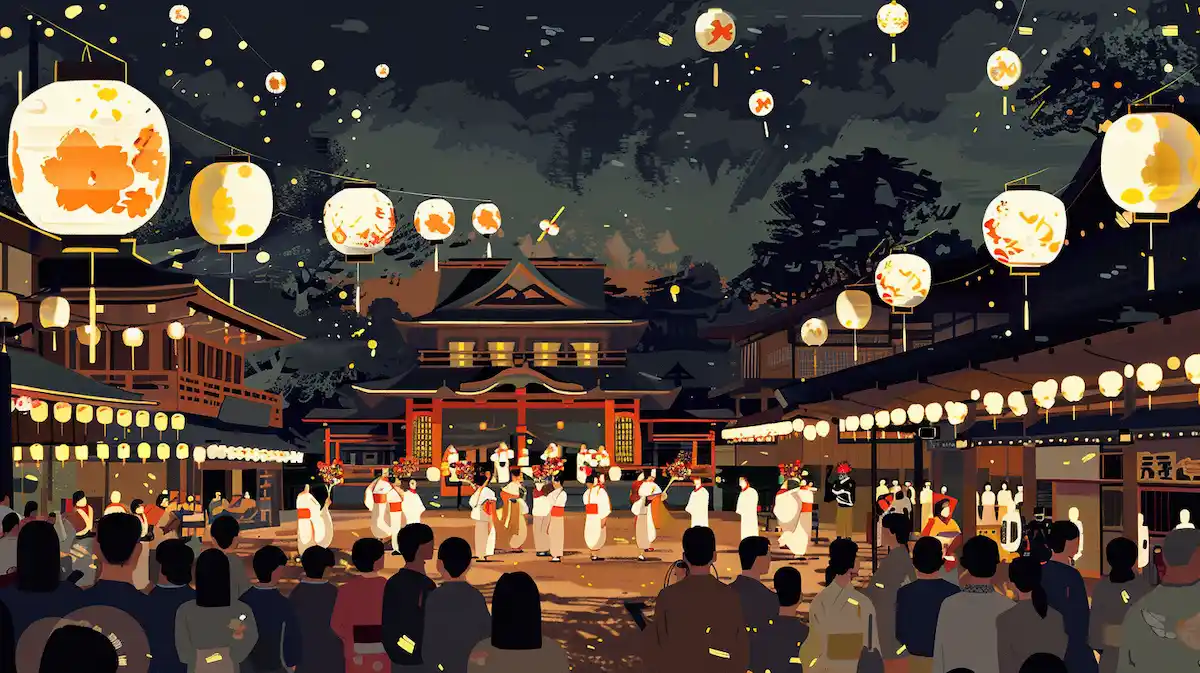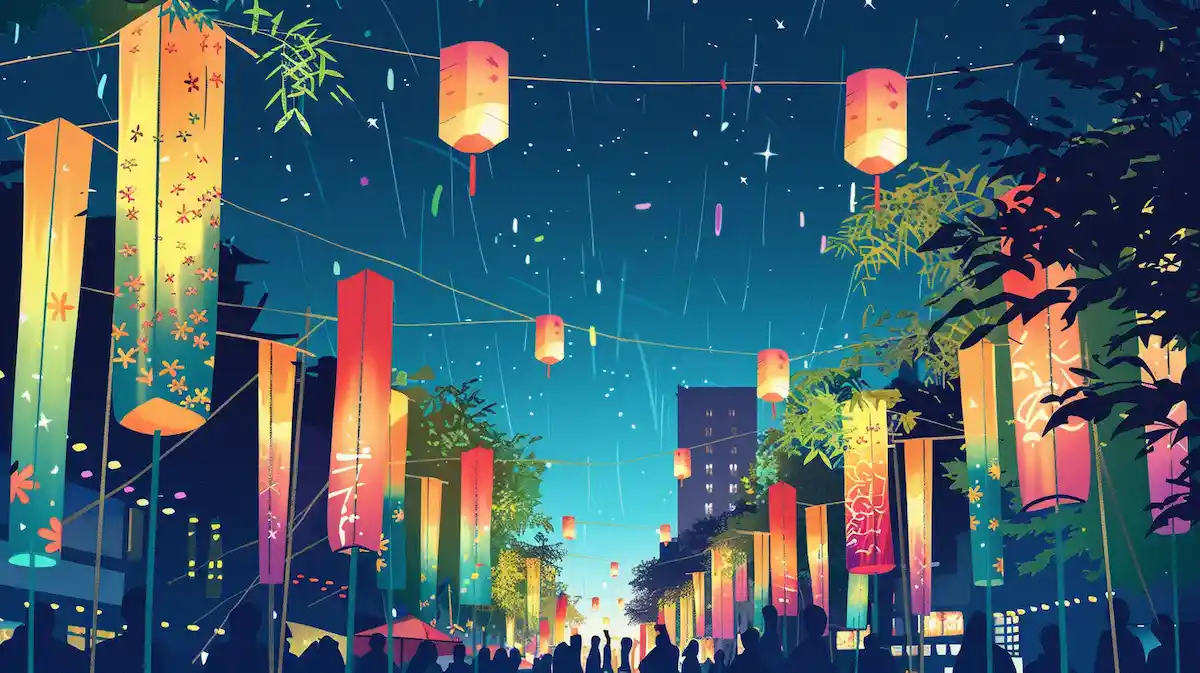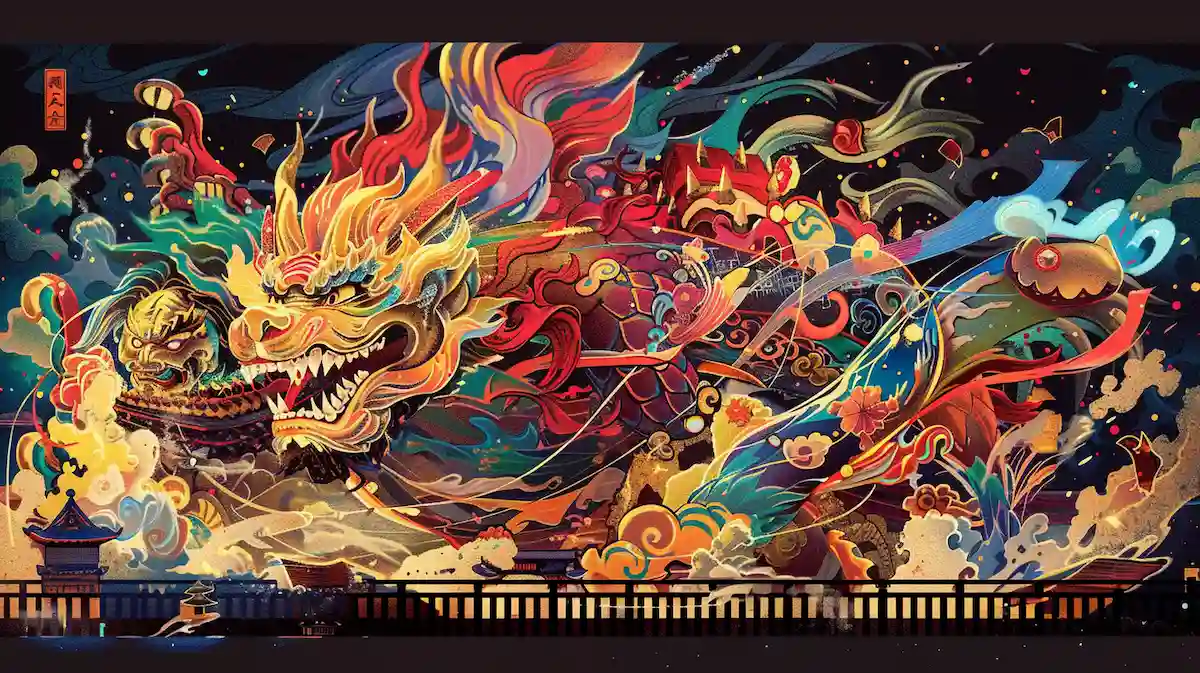ねぶた祭を英語で説明・紹介するための基本情報と、英会話に役立つ表現をシンプルでわかりやすい英語で紹介します。
英会話ダイアローグ・関連情報・10の質問を通して、ねぶた祭に関する英語表現を学びます。
英語
英会話ダイアローグを読む前に知っておくと良い前提知識と情報は以下の通りです。
- 青森ねぶた祭の概要
- 開催時期: 毎年8月2日から7日まで青森市で開催
- 特徴: 巨大で色鮮やかな「ねぶた」と呼ばれる灯篭がメインで、歴史的な人物や神話のキャラクターを描いたものが多い
- ねぶたの由来
- 起源: 約300年前の江戸時代中期に遡り、「ねぶり流し」という悪霊を追い払う儀式から発展
- 目的: 悪霊払いと豊作祈願、地域の結束と文化継承、観光振興など
- 祭りの楽しみ方
- 見どころ: 巨大なねぶた灯篭のパレード、エネルギッシュなハネトの踊り、迫力ある太鼓や囃子、最終日の花火大会
- 参加方法: 観光客も「ハネト」として踊りに参加可能。衣装レンタルが可能
- 宿泊と観光
- 宿泊: 祭り期間中はホテルが混雑するため、早めの予約が必要
- 観光スポット: 青森県立美術館や三内丸山遺跡など、訪れる価値のある場所がある
2人が青森ねぶた祭について話しています。
ねぶた祭の歴史、見どころ、東北三大祭のひとつであること、参加方法や最終日の花火大会などを話題にしています。
会話 / dialogue

Hey Key, I’ve been hearing a lot about the Aomori Nebuta Festival lately. Have you ever been?

Yes, I went last year! It’s one of the Three Great Festivals of Tohoku. Are you interested in going?

Definitely! I love festivals and this one sounds amazing. Can you tell me more about it?

Sure! The Nebuta Festival is held in Aomori City every year from August 2nd to 7th. It’s famous for its giant, illuminated floats called “nebuta.”

What are these floats like?

They’re huge and beautifully crafted, depicting historical figures, mythological characters, and warriors. Some are up to 5 meters tall and 9 meters wide.

That sounds impressive. What’s the origin of the festival?

The festival’s roots go back about 300 years to the Edo period. It evolved from a ritual called “Neburi Nagashi,” which was meant to ward off evil spirits.

Interesting! What can visitors do at the festival?

You can watch the parade of floats, and if you want to be more involved, you can join the “haneto” dancers. They jump and chant “Rassera, Rassera” around the floats. Anyone can join by renting a haneto costume.

That sounds like a lot of fun! Is there anything special on the last day?

Yes, the festival ends with a spectacular fireworks display. The combination of the illuminated floats and fireworks is really something to see.

I heard it’s very popular. Do you think I need to book accommodation in advance?

Definitely. Hotels fill up quickly during the festival, so it’s best to book as early as possible.

Thanks for the tip. Any must-see attractions while I’m there?

Besides the festival itself, you should check out the Aomori Museum of Art and the Sannai Maruyama archaeological site. They’re both quite interesting.

Sounds good. How should I get around the city?

Public transport can be crowded, so consider using taxis or walking if you’re staying near the festival area.

I can’t wait! It sounds like an unforgettable experience.

It really is. You’ll love the energy and the amazing visual displays. Make sure to bring a camera!

I will. Thanks for all the information, Key. I’m really looking forward to it now.

You’re welcome, Mack. Enjoy the festival and have a great time in Aomori!
関連情報 / related information
「ねぶた祭」について、理解を深めるための「英語での関連情報」です。
ねぶた祭

Overview of the Aomori Nebuta Festival
The Aomori Nebuta Festival is a famous summer event in Aomori City, Japan. It happens every year from August 2nd to 7th. The festival is known for its large and colorful floats called “nebuta.” These floats show historical figures, warriors, and characters from myths. They are very big, sometimes up to 5 meters tall and 9 meters wide. At night, the floats light up and look magical.
History and Origin
The festival started about 300 years ago, during the Edo period. It began as a ritual called “Neburi Nagashi.” This ritual was meant to drive away evil spirits and bring good luck. Over time, it changed and grew into the festival we see today. The main purposes are to ward off evil, pray for good harvests, and bring the community together.
Activities and Participation
During the festival, you can watch the floats parade through the streets. There are also dancers called “haneto” who jump and shout “Rassera, Rassera” around the floats. Visitors can join in by renting a haneto costume. The festival ends with a big fireworks show on the last day. The combination of lit-up floats and fireworks is very beautiful.
Accommodation and Sightseeing
If you plan to visit, book your hotel early because it gets very crowded. While in Aomori, you can also visit other interesting places like the Aomori Museum of Art and the Sannai Maruyama archaeological site. These spots offer a good mix of culture and history.
10の質問 / 10 questions
「ねぶた祭」について、理解を深めるための「英語での10の質問」です。
1: What is the Aomori Nebuta Festival?
The Aomori Nebuta Festival is a famous summer festival held in Aomori City, Japan, every year from August 2nd to 7th. It features large, illuminated floats called "nebuta."
2: What are nebuta floats?
Nebuta floats are giant, colorful structures that depict historical figures, warriors, and characters from myths. They are made of wire, wood, and paper, and are illuminated from inside.
3: When did the Aomori Nebuta Festival start?
The festival began about 300 years ago, during the Edo period. It evolved from a ritual called "Neburi Nagashi," which was meant to ward off evil spirits.
4: Who are the haneto dancers?
Haneto dancers are participants in the festival who jump and dance around the nebuta floats, chanting "Rassera, Rassera." They wear traditional costumes and add energy to the parade.
5: Can visitors participate in the Aomori Nebuta Festival?
Yes, visitors can join the festival as haneto dancers by renting a haneto costume and joining the parade.
6: What is the purpose of the Aomori Nebuta Festival?
The festival was originally meant to ward off evil spirits and pray for a good harvest. Today, it also celebrates local culture and brings the community together.
7: What happens on the last day of the festival?
The last day of the festival features a spectacular fireworks display. The combination of illuminated floats and fireworks creates a magical atmosphere.
8: How popular is the Aomori Nebuta Festival?
The festival is very popular, attracting hundreds of thousands of visitors from Japan and abroad every year.
9: What should I do to prepare for the Aomori Nebuta Festival?
It’s important to book your accommodation early because hotels fill up quickly. You might also want to rent a haneto costume if you plan to participate.
10: What else can I see in Aomori besides the festival?
In Aomori, you can visit the Aomori Museum of Art and the Sannai Maruyama archaeological site, both of which offer interesting cultural and historical experiences.
和訳付
会話 / dialogue

Hey Key, I’ve been hearing a lot about the Aomori Nebuta Festival lately. Have you ever been?
キー、最近青森ねぶた祭についてよく聞くんだけど、行ったことある?

Yes, I went last year! It’s one of the Three Great Festivals of Tohoku. Are you interested in going?
うん、去年行ったよ!東北三大祭りのひとつだよ。行ってみたい?

Definitely! I love festivals and this one sounds amazing. Can you tell me more about it?
もちろん!祭りが大好きだから、これはすごく面白そう。もっと教えてくれる?

Sure! The Nebuta Festival is held in Aomori City every year from August 2nd to 7th. It’s famous for its giant, illuminated floats called “nebuta.”
もちろん!ねぶた祭は毎年8月2日から7日にかけて青森市で開催されるんだ。巨大で光り輝く「ねぶた」と呼ばれる灯篭で有名だよ。

What are these floats like?
その灯篭ってどんな感じなの?

They’re huge and beautifully crafted, depicting historical figures, mythological characters, and warriors. Some are up to 5 meters tall and 9 meters wide.
すごく大きくて美しく作られていて、歴史上の人物や神話のキャラクター、武士なんかを描いているんだ。高さ5メートル、幅9メートルのものもあるよ。

That sounds impressive. What’s the origin of the festival?
それはすごいね。祭りの起源は何なの?

The festival’s roots go back about 300 years to the Edo period. It evolved from a ritual called “Neburi Nagashi,” which was meant to ward off evil spirits.
祭りの起源は約300年前の江戸時代に遡るんだ。「ねぶり流し」という悪霊を追い払う儀式から発展したものなんだ。

Interesting! What can visitors do at the festival?
面白いね!祭りでは訪問者は何ができるの?

You can watch the parade of floats, and if you want to be more involved, you can join the “haneto” dancers. They jump and chant “Rassera, Rassera” around the floats. Anyone can join by renting a haneto costume.
灯篭のパレードを見ることができるし、もっと参加したいなら「ハネト」の踊りに参加できるよ。彼らは「ラッセーラー、ラッセーラー」と叫びながら跳ね回るんだ。ハネトの衣装をレンタルすれば誰でも参加できるよ。

That sounds like a lot of fun! Is there anything special on the last day?
それは楽しそう!最終日に何か特別なことはあるの?

Yes, the festival ends with a spectacular fireworks display. The combination of the illuminated floats and fireworks is really something to see.
うん、祭りの最後は壮大な花火大会で締めくくられるんだ。光り輝く灯篭と花火の組み合わせは本当に見ものだよ。

I heard it’s very popular. Do you think I need to book accommodation in advance?
すごく人気があるって聞いたんだけど、宿泊先は事前に予約する必要があるかな?

Definitely. Hotels fill up quickly during the festival, so it’s best to book as early as possible.
絶対に必要だよ。祭りの期間中はホテルがすぐに満室になるから、できるだけ早く予約するのがいいよ。

Thanks for the tip. Any must-see attractions while I’m there?
助言ありがとう。そこに行ったら必見の観光スポットはある?

Besides the festival itself, you should check out the Aomori Museum of Art and the Sannai Maruyama archaeological site. They’re both quite interesting.
祭り以外には、青森県立美術館と三内丸山遺跡を見てみるといいよ。どちらもすごく面白いよ。

Sounds good. How should I get around the city?
いいね。市内ではどうやって移動するのがいい?

Public transport can be crowded, so consider using taxis or walking if you’re staying near the festival area.
公共交通機関は混雑することがあるから、祭りのエリアに近くに滞在するならタクシーや徒歩を考えるといいよ。

I can’t wait! It sounds like an unforgettable experience.
楽しみだな!忘れられない体験になりそうだね。

It really is. You’ll love the energy and the amazing visual displays. Make sure to bring a camera!
本当にそうだよ。エネルギーと素晴らしいビジュアルが大好きになると思うよ。カメラを忘れずにね!

I will. Thanks for all the information, Key. I’m really looking forward to it now.
忘れないよ。キー、情報をありがとう。今から本当に楽しみだよ。

You’re welcome, Mack. Enjoy the festival and have a great time in Aomori!
どういたしまして、マック。祭りを楽しんで、青森で素晴らしい時間を過ごしてね!
関連情報 / related information
ねぶた祭

Overview of the Aomori Nebuta Festival
The Aomori Nebuta Festival is a famous summer event in Aomori City, Japan. It happens every year from August 2nd to 7th. The festival is known for its large and colorful floats called “nebuta.” These floats show historical figures, warriors, and characters from myths. They are very big, sometimes up to 5 meters tall and 9 meters wide. At night, the floats light up and look magical.
青森ねぶた祭は、日本の青森市で毎年夏に開催される有名なイベントです。毎年8月2日から7日にかけて行われます。祭りは「ねぶた」と呼ばれる大きくてカラフルな灯篭で知られています。これらの灯篭は、歴史上の人物や武士、神話のキャラクターを描いています。非常に大きく、高さ5メートル、幅9メートルにもなることがあります。夜になると、灯篭はライトアップされ、幻想的に見えます。
History and Origin
The festival started about 300 years ago, during the Edo period. It began as a ritual called “Neburi Nagashi.” This ritual was meant to drive away evil spirits and bring good luck. Over time, it changed and grew into the festival we see today. The main purposes are to ward off evil, pray for good harvests, and bring the community together.
祭りは約300年前の江戸時代に始まりました。「ねぶり流し」と呼ばれる儀式から始まりました。この儀式は、悪霊を追い払い、幸運をもたらすためのものでした。時間が経つにつれて、現在の形の祭りに変わり、発展してきました。主な目的は、悪霊払い、豊作祈願、そして地域の結束を強めることです。
Activities and Participation
During the festival, you can watch the floats parade through the streets. There are also dancers called “haneto” who jump and shout “Rassera, Rassera” around the floats. Visitors can join in by renting a haneto costume. The festival ends with a big fireworks show on the last day. The combination of lit-up floats and fireworks is very beautiful.
祭りの間、灯篭が街をパレードするのを見ることができます。また、「ハネト」と呼ばれる踊り手たちが、灯篭の周りで「ラッセーラー、ラッセーラー」と叫びながら跳ね回ります。観光客もハネトの衣装をレンタルして参加することができます。祭りは最終日に大きな花火大会で締めくくられます。ライトアップされた灯篭と花火の組み合わせは非常に美しいです。
Accommodation and Sightseeing
If you plan to visit, book your hotel early because it gets very crowded. While in Aomori, you can also visit other interesting places like the Aomori Museum of Art and the Sannai Maruyama archaeological site. These spots offer a good mix of culture and history.
訪れる予定があるなら、早めにホテルを予約してください。非常に混雑します。青森にいる間、青森県立美術館や三内丸山遺跡などの他の興味深い場所も訪れることができます。これらのスポットは、文化と歴史の良い組み合わせを提供します。
10の質問 / 10 questions
1: What is the Aomori Nebuta Festival?
青森ねぶた祭とは何ですか?
The Aomori Nebuta Festival is a famous summer festival held in Aomori City, Japan, every year from August 2nd to 7th. It features large, illuminated floats called "nebuta."
青森ねぶた祭は、日本の青森市で毎年8月2日から7日にかけて開催される有名な夏祭りです。巨大な「ねぶた」と呼ばれる灯篭が特徴です。
2: What are nebuta floats?
ねぶた灯篭とは何ですか?
Nebuta floats are giant, colorful structures that depict historical figures, warriors, and characters from myths. They are made of wire, wood, and paper, and are illuminated from inside.
ねぶた灯篭は、歴史上の人物や武士、神話のキャラクターを描いた巨大でカラフルな構造物です。ワイヤー、木材、紙で作られ、内部から照らされています。
3: When did the Aomori Nebuta Festival start?
青森ねぶた祭はいつ始まりましたか?
The festival began about 300 years ago, during the Edo period. It evolved from a ritual called "Neburi Nagashi," which was meant to ward off evil spirits.
この祭りは約300年前の江戸時代に始まりました。「ねぶり流し」と呼ばれる悪霊を追い払う儀式から発展しました。
4: Who are the haneto dancers?
ハネトの踊り手とは誰ですか?
Haneto dancers are participants in the festival who jump and dance around the nebuta floats, chanting "Rassera, Rassera." They wear traditional costumes and add energy to the parade.
ハネトの踊り手は、ねぶた灯篭の周りで「ラッセーラー、ラッセーラー」と叫びながら跳ね回る祭りの参加者です。彼らは伝統的な衣装を着て、パレードに活気を与えます。
5: Can visitors participate in the Aomori Nebuta Festival?
観光客も青森ねぶた祭に参加できますか?
Yes, visitors can join the festival as haneto dancers by renting a haneto costume and joining the parade.
はい、観光客もハネトの衣装をレンタルしてパレードに参加することができます。
6: What is the purpose of the Aomori Nebuta Festival?
青森ねぶた祭の目的は何ですか?
The festival was originally meant to ward off evil spirits and pray for a good harvest. Today, it also celebrates local culture and brings the community together.
この祭りはもともと悪霊を追い払い、豊作を祈るためのものでした。現在では、地域の文化を祝うとともに、地域社会を一つにまとめる役割も果たしています。
7: What happens on the last day of the festival?
祭りの最終日には何が起こりますか?
The last day of the festival features a spectacular fireworks display. The combination of illuminated floats and fireworks creates a magical atmosphere.
祭りの最終日には壮大な花火大会が行われます。ライトアップされた灯篭と花火の組み合わせは、幻想的な雰囲気を作り出します。
8: How popular is the Aomori Nebuta Festival?
青森ねぶた祭はどのくらい人気がありますか?
The festival is very popular, attracting hundreds of thousands of visitors from Japan and abroad every year.
この祭りは非常に人気があり、毎年何十万人もの国内外の観光客を引き寄せています。
9: What should I do to prepare for the Aomori Nebuta Festival?
青森ねぶた祭に備えるために何をすべきですか?
It’s important to book your accommodation early because hotels fill up quickly. You might also want to rent a haneto costume if you plan to participate.
ホテルがすぐに満室になるので、早めに宿泊施設を予約することが重要です。参加する予定があるなら、ハネトの衣装をレンタルするのも良いでしょう。
10: What else can I see in Aomori besides the festival?
祭り以外に青森で何を見ることができますか?
In Aomori, you can visit the Aomori Museum of Art and the Sannai Maruyama archaeological site, both of which offer interesting cultural and historical experiences.
青森では、青森県立美術館や三内丸山遺跡を訪れることができ、どちらも興味深い文化的・歴史的体験を提供します。
words & phrases
英会話ダイアローグと関連情報に出てきた単語・フレーズです(例文は各3つ)。

mythological: 形容詞
意味: 神話の、神話に関する。Relating to or based on myths or mythology.
(祭りのねぶた灯篭が神話のキャラクターを描いていることを指す)
例文
The nebuta floats depict mythological characters.
「ねぶた灯篭は神話のキャラクターを描いています。」
Greek temples are filled with mythological stories.
「ギリシャの神殿には神話の物語がたくさんあります。」
She loves reading about mythological creatures.
「彼女は神話の生き物について読むのが大好きです。」
chant: 動詞
意味: 歌う、唱える。To sing or intone to a monotonous, repetitive rhythm.
(ハネトの踊り手たちが「ラッセーラー」と唱えることを指す)
例文
The haneto dancers chant “Rassera, Rassera” during the festival.
「ハネトの踊り手たちは祭りの間に「ラッセーラー、ラッセーラー」と唱えます。」
The monks chant prayers every morning.
「僧侶たちは毎朝お経を唱えます。」
The crowd began to chant the team’s name.
「群衆はチームの名前を唱え始めました。」
fireworks display: 名詞
意味: 花火大会。A public show of fireworks.
(祭りの最後に行われる花火大会を指す)
例文
The festival ends with a spectacular fireworks display.
「祭りは壮大な花火大会で締めくくられます。」
We enjoyed the fireworks display on New Year’s Eve.
「私たちは大晦日の花火大会を楽しみました。」
The fireworks display lit up the night sky.
「花火大会が夜空を照らしました。」
accommodation: 名詞
意味: 宿泊施設。A place to stay, such as a hotel or inn.
(祭り期間中の宿泊施設を指す)
例文
Book your accommodation early because it gets very crowded.
「非常に混雑するので、早めに宿泊施設を予約してください。」
The hotel provides comfortable accommodation for guests.
「そのホテルは快適な宿泊施設を提供しています。」
Finding accommodation during the festival can be difficult.
「祭りの間に宿泊施設を見つけるのは難しいことがあります。」
ward off: 句動詞
意味: 追い払う、防ぐ。To prevent someone or something from harming or affecting you.
(祭りの起源としての悪霊を追い払う儀式を指す)
例文
The festival was originally meant to ward off evil spirits.
「祭りはもともと悪霊を追い払うためのものでした。」
She wore garlic to ward off vampires.
「彼女は吸血鬼を追い払うためにニンニクを身につけました。」
We used bug spray to ward off mosquitoes.
「蚊を追い払うために虫除けスプレーを使いました。」
詳細情報 / Further Info
関連記事(秋田竿燈まつり、仙台七夕まつり)


